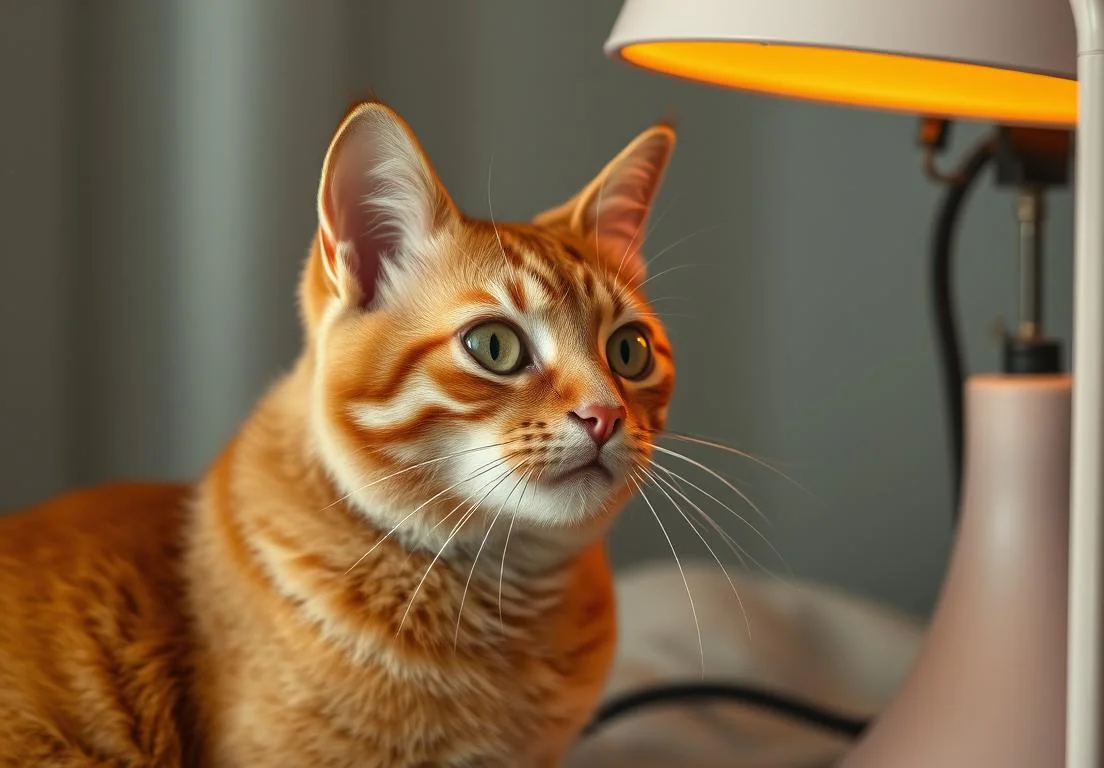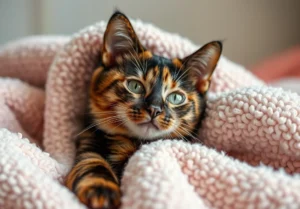Cats love warmth, but the right source of heat is essential to their safety. While heat lamps might seem like a cozy addition to your feline’s space, it’s crucial to evaluate whether they truly enhance your pet’s comfort or pose risks.
Yes, heat lamps can be safe for cats if used properly, taking into consideration their temperature levels and placement. However, overheating and burns are serious risks, so caution is key. Curious how to navigate the potential hazards and benefits further? There’s more insight waiting below that you won’t want to miss.

What Are Heat Lamps and How Do They Work?
Heat lamps are a popular choice for providing warmth in various settings, from restaurants to pet care. These devices emit infrared radiation, which helps to warm up the surrounding area. Typically, heat lamps consist of a bulb encased in a reflective or glass cover, allowing for efficient heat distribution.
In households, heat lamps are commonly used for kitchens, especially to keep food warm. However, when it comes to pets, particularly cats, the focus shifts to their comfort and safety. These lamps can be particularly useful in colder months, providing a designated warm spot that mimics the sun’s heat. They’re especially prevalent in animal shelters and breeders for keeping newborn kittens snug and cozy. Importantly, understanding how these lamps work can help ensure they are used safely around our feline friends.
Are Heat Lamps Suitable for Indoor Cats?
While indoor cats often find comfort in warm, cozy nooks, they might not necessarily need a heat lamp. Most homes offer enough ambient warmth, especially if you’re cranking up the heater or if the sun shines into your living space. However, specific situations can make heat lamps beneficial.
For example, if your home tends to be drafty during winter or if you have an older cat that struggles to maintain body heat, a heat lamp can provide extra comfort. Here are a couple of points to consider:
-
Placement Matters: Ensure the heat lamp is positioned safely out of reach. Cats are naturally curious, and if they get too close, they can risk burns or overheating.
-
Monitor Temperature: Cats can easily overheat, so maintaining a comfortable temperature range is crucial.
Ideally, the lamp should create a warm zone without turning the entire area into a sauna.
To verify the importance of temperature control for cats, consider the general temperature tolerance range for domestic cats, which is typically around 101 to 102.5 degrees Fahrenheit. Excessive heat, beyond this range, can lead to overheating, leaving cats vulnerable to heatstroke. Monitoring the surrounding temperature with a thermometer can showcase the difference between a safe warm zone and an overheating area. Setting a heat lamp to produce a localized temperature around 85 to 90 degrees Fahrenheit can help ensure a safe and comfortable environment for indoor cats, thereby avoiding overheating.
Using heat lamps should be done with discretion, looking out for signs that your cat may be too warm, such as panting or seeking cooler spots. If you’re unsure, consulting with your vet can provide tailored insights specific to your cat’s health and needs.
What Risks Do Heat Lamps Pose to Cats?
Heat lamps can be a real concern for our furry friends. While they provide warmth, they also pose risks like burns and overheating. Cats are naturally curious and might get too close, risking skin burns—not to mention, their whiskers can get singed! Overheating is another potential hazard; a cat can easily overheat if the heat lamp is too strong or left on for too long. This could lead to serious health issues, like heatstroke, which isn’t just uncomfortable but can be life-threatening.
Additionally, there’s a risk of fire hazards if the lamp is poorly positioned or if flammable materials are nearby. It’s important to remember that a cat’s behavior might change too; if they’re too warm, they may become lethargic or restless. Keeping a close eye on how your cat responds to the heat can help prevent discomfort or health issues stemming from these risks.
How Should Heat Lamps Be Used Around Cats?
Using heat lamps around cats requires some thoughtful precautions. To keep your cat safe and comfy, consider these guidelines:
-
Placement Matters : Position the heat lamp in a way that your cat can’t easily access it. Elevated or fenced-off areas can be ideal.
-
Temperature Control : Use lamps with adjustable settings. Make sure you periodically check and adjust the heat to avoid overheating.
-
Limit Exposure : Avoid having the lamp on for extended periods. Short, controlled sessions of warmth are safer than prolonged exposure.
-
Safety Features : Opt for lamps that come with safety features like automatic shut-off timers to prevent overheating.
-
Supervision is Key : Always keep an eye on your cat during use. Cats should have the option to move away if they get too warm.
Choosing the right type of heat lamp can also make a difference. Infrared heat lamps provide a steady warmth that can be less intense than standard heat lamps, reducing the risk of burns.
By following these tips, you can create a warm and safe environment that keeps your cat both cozy and secure.
What Are the Signs of Overheating in Cats?
Cats can be remarkably resilient, but overexposure to heat lamps can lead to overheating, which is concerning. Watch for signs that your furry friend might be too hot. Common symptoms include:
- Excessive Panting: Unlike dogs, cats rarely pant. If yours is panting heavily, it’s a red flag.
- Lethargy: If your cat seems unusually tired or unwilling to move, they might be feeling the heat.
- Drooling: Overheating can trigger excessive drooling, which is not typical for most cats.
- Rapid Heartbeat: You might notice their heart racing, even at rest.
- Restlessness: Overheated cats may act fidgety or try to escape the heat source.
Be mindful of these signs and adjust their environment accordingly. Proper ventilation and giving your cat the option to move away from the heat are essential. Always keep an eye on them to ensure they’re comfortable.
Can Heat Lamps Help Cats with Medical Conditions?
Heat lamps aren’t just appliances; they can play a supportive role in healing specific medical conditions in cats. For instance, cats recovering from surgery or injury might benefit from the gentle warmth of a heat lamp, which can improve circulation and accelerate healing.
It’s essential, however, to use them wisely. Here’s how to utilize heat lamps effectively:
- Set Appropriate Distances: Maintain a safe distance of at least 18 inches to prevent burns.
- Limit Exposure: Don’t leave the lamp on for extended periods. Start with short sessions and monitor your cat’s response.
- Consider the Condition: Cats suffering from arthritis may find relief from joint pain with gentle heat, while kittens needing warmth can benefit significantly.
- Ensure Access to Cool Areas: Always provide a space for your cat to move away from the heat if they want to.
One unique angle to consider involves wetness. If your cat enjoys warmth due to skin conditions, combining a heat lamp with damp cloths can soothe irritated skin and encourage healing. Always consult with your vet before integrating a heat lamp into your cat’s care routine to ensure it’s the right fit for their specific needs.
What Alternatives to Heat Lamps Are Available?
Keeping your cat cozy doesn’t have to hinge on heat lamps, which can pose risks of burns or overheating. There are plenty of alternatives that keep your feline friend warm and safe.
Electric heated beds are a fantastic option. They’re designed specifically for pets, often featuring safe, low-watt heat sources that evenly distribute warmth. Most come with adjustable temperature settings, allowing you to find just the right level of comfort.
Microwavable heat pads provide another safe choice. These pads can be warmed up in your microwave and placed in your cat’s bed. They offer a warm cuddle without any electrical hazards—just remember to monitor the temperature to prevent burns!
Insulated blankets or thermal covers can help trap your pet’s body heat. Look for materials that are plush and soft, encouraging snuggly behavior. Some blankets are even designed with reflective materials to bounce heat back to your cat.
Lastly, consider creating a warm den or sanctuary in your home. You can line a box with blankets or use a cat cave to give your pet a cozy, insulated place to curl up. Combining these options creates a safe haven without the worries that come with heat lamps.
Are There Specific Heat Lamps Designed for Pets?
Some heat lamps on the market are indeed designed with pets in mind, focusing on safety and efficiency. They tend to incorporate features that reduce risks. For instance, ceramic heat emitters generate warmth without emitting visible light, which can be less startling for cats and prevent hyperactivity.
When looking for a heat lamp, choose one with protective guards to minimize the risk of burns or injuries from accidental contact. Also, adjustable mounts help you position the heat source at a safe distance from your cat, ensuring they can bask in warmth without the risk of overheating.
Consider lamps that use infrared technology. They not only heat spaces efficiently but also penetrate deeper into your pet’s muscles, enhancing warmth without direct contact.
It’s key to monitor your cat’s behavior when introducing any heat lamp. If your cat seems uncomfortable or tries to move away, the temperature might need adjustment. Always aim for a warm but comfortable environment. This way, your cat can enjoy the benefits without the associated risks of traditional heat lamps.
Interesting Facts About Cats and Temperature Regulation
Cats are fascinating when it comes to temperature regulation. Unlike humans, who sweat to cool down, cats primarily use panting and grooming to manage heat. Their fur acts as an insulating layer, helping them retain warmth in chilly environments. Interestingly, a cat’s normal body temperature hovers around 101 to 102.5 degrees Fahrenheit, so they naturally prefer warmer spaces.
Have you ever noticed that your feline friend seeks out sunny spots? It’s no accident. Cats instinctively gravitate toward warmth, often choosing sunny windowsills or heated blankets to lounge on. This behavior isn’t just about comfort; it’s evolutionary. Felines evolved in warmer climates, and they still crave those cozy spots for optimal energy conservation.
Another intriguing aspect is how younger and older cats handle temperature. Kittens struggle to regulate their body heat and can get too cold easily. On the other hand, senior cats often have diminished senses and could require extra warmth to keep their joints comfortable.
When it comes to artificial heat sources, a heat lamp might seem like a good idea, but it’s essential to consider safety. Using heat lamps for cats can be risky. They may inadvertently get too close and suffer from burns, or they could tip over, posing a fire hazard. If you’re thinking about using one, make sure it’s positioned well out of paw reach, ideally on a timer, and monitored regularly to prevent accidents.
In short, while cats appreciate warmth, care must be taken to ensure they’re safe when using heat lamps, given their natural affinity for cozy spots. Keeping an eye on how your pet reacts to heat can help you better support their needs.
Alex, a passionate animal lover, has experience in training and understanding animal behavior. As a proud pet parent to two dogs and three cats, he founded AnimalReport.net to share insights from animal experts and expand his knowledge of the animal kingdom.




